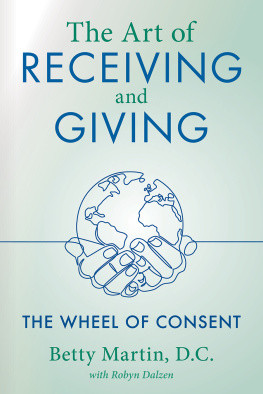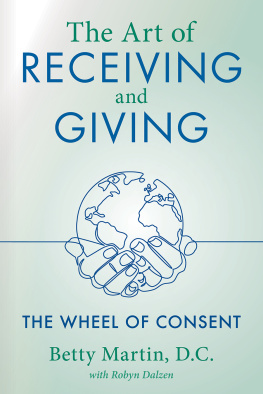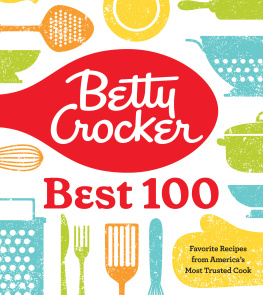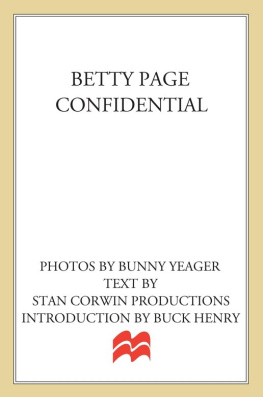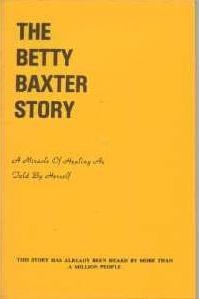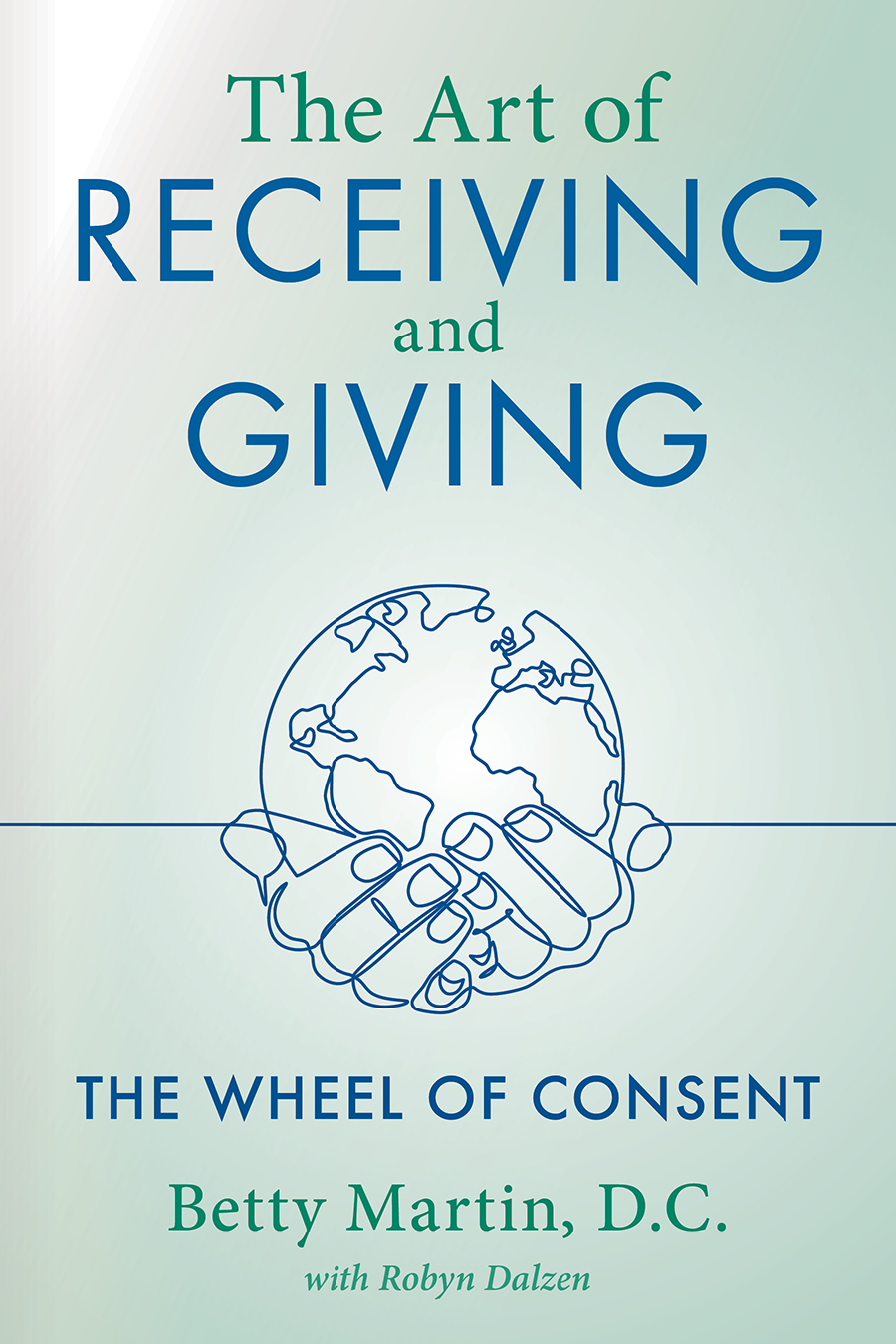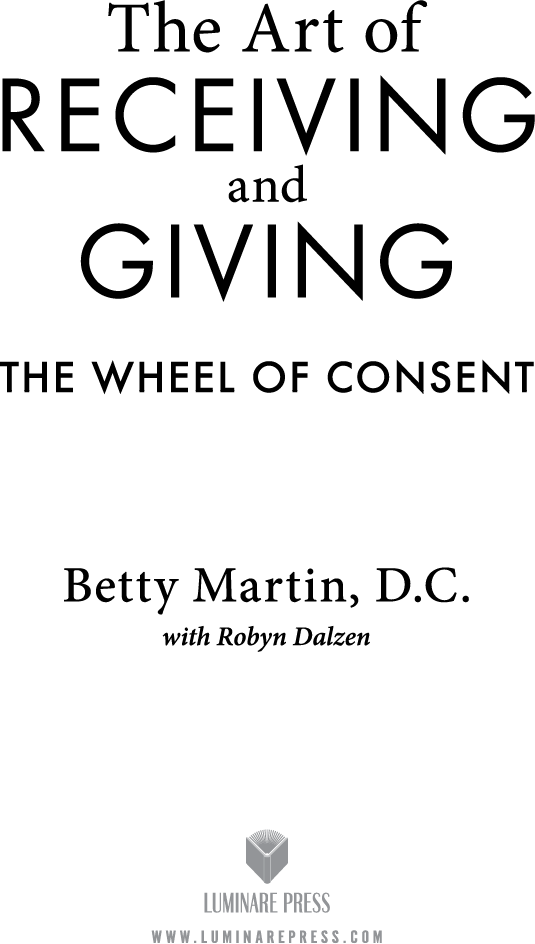Betty Martin - The Art of Receiving and Giving: The Wheel of Consent
Here you can read online Betty Martin - The Art of Receiving and Giving: The Wheel of Consent full text of the book (entire story) in english for free. Download pdf and epub, get meaning, cover and reviews about this ebook. year: 2021, publisher: Betty Martin, genre: Home and family. Description of the work, (preface) as well as reviews are available. Best literature library LitArk.com created for fans of good reading and offers a wide selection of genres:
Romance novel
Science fiction
Adventure
Detective
Science
History
Home and family
Prose
Art
Politics
Computer
Non-fiction
Religion
Business
Children
Humor
Choose a favorite category and find really read worthwhile books. Enjoy immersion in the world of imagination, feel the emotions of the characters or learn something new for yourself, make an fascinating discovery.
- Book:The Art of Receiving and Giving: The Wheel of Consent
- Author:
- Publisher:Betty Martin
- Genre:
- Year:2021
- Rating:3 / 5
- Favourites:Add to favourites
- Your mark:
The Art of Receiving and Giving: The Wheel of Consent: summary, description and annotation
We offer to read an annotation, description, summary or preface (depends on what the author of the book "The Art of Receiving and Giving: The Wheel of Consent" wrote himself). If you haven't found the necessary information about the book — write in the comments, we will try to find it.
Why would most people endure unwanted or unsatisfying touch, rather than speak up for their own boundaries and desires? Its a question with a myriad of answers - and one that Dr. Betty Martin has explored in her 40+ years as a hands-on practitioner, first as a chiropractor and later as a Somatic Sex Educator, Certified Surrogate Partner and Sacred Intimate. In her client sessions, she noticed a pattern wherein many clients would allow or go along with discomfort or unease rather than speak up for what they wanted or didnt want. Betty discovered there was a major component missing for people the confidence that we have a choice about what is happening to us.
In her framework, The Wheel of Consent Betty traces the fundamental roots of consent back to our childhood conditioning. As children, we are taught that to be good we must ignore our bodys discomfort and be compliant: to finish our food even if were full, to go to bed - even if were not tired, to let relatives hug and kiss us even if we dont want to. We learn that our feelings dont matter more than what is happening, and that we dont have a choice but to go along, whether or not we want it.
As adults, this conditioning remains with us until we have an opportunity to unlearn it, which is why consent violations are often only called out after the violation has occurred - because we have not been taught or empowered to notice our boundaries, much less value or express our internal signals as the unwanted action is happening.
In this book, Betty guides the reader through the Wheel of Consent framework, and shares practices to help us recover the ability to notice what we want and set clear boundaries. While the practices are based on exchanges of touch, they can also be learned without touch. In these practices, we discover that the Art of Giving includes knowing our own limits so we can be more generous within those limits, and not give beyond our capacity - a common problem which creates feelings of resentment or martyrdom. We also discover that the Art of Receiving invites us to notice and ask for what we really want, and not just what we think we are supposed to want. This knowledge, and its embodied practice, is foundational for creating clear agreements and bringing more satisfaction into relationships.
While much of consent education focuses on noticing what we dont want, or prevention of violation, Betty has developed a pleasure-forward approach to teaching consent. By first accessing and awakening (sometimes re-awakening) our bodies relationship to pleasure and what we want, we can practice noticing and verbalizing what we dont want. Such an approach provides a more holistic frame in which to unlearn the childhood conditioning that taught us to be silent and compliant, and in which individuals can learn to ask for what they want and state what they dont, in a more empowered way.
The implications of this approach to consent education extends beyond touch and intimate relationships. When we forget how to notice what we really want, we lose our inner compass. When we continue to go along with things we dont feel are right, we lose our ability to speak up against injustice. This has a profound effect on society. We allow all manner of inequality, corruption, theft of natural resources and our planets future health - because going along with it feels normal.
The #MeToo movement exposed the pervasiveness of boundary violations in modern culture. The Wheel of Consent offers a deeply nuanced way to practice consent as an agreement that brings integrity, responsibility,...
Betty Martin: author's other books
Who wrote The Art of Receiving and Giving: The Wheel of Consent? Find out the surname, the name of the author of the book and a list of all author's works by series.

